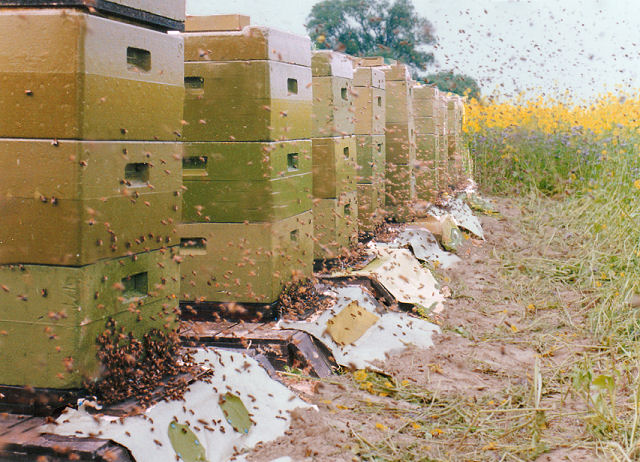This was exactly two weeks after I first installed my bees. I read in a book, that it is best to visit the hive between the hours of 10:00 am and 5:00 pm. Doing so ensures that not all the bees are in residence at one time. In this first picture, I am preparing my smoker. I crumpled up one page of newspaper and then stuffed some match-stick sized branches in on top. Once I got the flame going, I added some thicker pieces of kindling -- always making sure to pump the billows.

You can tell from the picture below that the smoker is almost ready to go. Also, if you look closely you will notice that I have a blue covered tupperware sitting beside the smoker. In the process of drawing out honeycomb the bees will also build some unruly comb, not in the proper place -- this comb is referred to as bur comb. This bur comb needs to be scraped off the frames or it will make handling the frames difficult in the future. When I scrape of the bur comb with my hive tool, I will store it in the tupperware (I want to collect as much beeswax as possible).
When opening the hive, it is recommended that you smoke the entrance. After doing so, I then removed the outer cover and smoked the hole in the inner cover. The picture below shows me opening the inner cover and giving a few more puffs to the bees. When I was smoking the bees, I could see them immediately scurry down into the hive.


Smoking the hive is effective for two reasons. First, it triggers an abandonment response in the bees. That is, the bees, believing the hive may be in danger prepare to abandon the hive by gorging themselves on honey. It is rumored, but not confirmed, that by eating honey, the bees' abdomen expands such that it makes it difficult for the bee to sting. Second, the smoke helps mask pheromones that alarm the rest of the hive that an intruder is present. The smoke also will mask the pheromones released by any squished bees.

This is a frame (below) in the earliest stages of comb building. You can see that the bees are hanging off of each other, getting ready to begin drawing out comb.

On this next frame, you can see the early stages of comb development. The comb is surprisingly white in color. Again, you will notice that I am using an organic beekeeping method that is completely wax-foundation free. This is pure natural comb produced all by my bees.

This frame has a little more comb drawn out. On this frame I could see into the individual cells of the comb. The bees store all sorts of things in the cells; everything from pollen and water, to baby bees (larval stage) and honey. I will get some better pictures up here in the future so you can see in to each cell.



Notice that this frame (below) is completely drawn out. Also, notice the bur comb popping up along the top bar. I used my hive tool to scrape this off and save it for later.

A better look at a fully drawn out frame. You can really see the bur comb and some capped honey.



This final picture (below) is of the frame that held the queen cage. As you can see, the bees started building comb all around the queen cage (made it a little difficult to remove it).

Click here to see a short video of my first hive inspection.



5 comments:
Amazing!!
Sweet!
Get it?
dude I am excited to come see those little buggers!
Nice work! How many stingers have you had to pull out of you so far?
The comb in my second hive is very white do you know why , i notice yours id too ?
Post a Comment